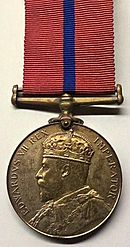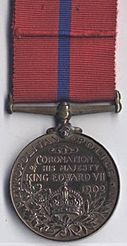King Edward VII Police Coronation Medal facts for kids
Quick facts for kids King Edward VII’s Police Coronation Medal |
|
|---|---|
|
Obverse and reverse: Metropolitan Police version.
|
|
| Presented by | United Kingdom |
The Police Coronation Medal was a special award given in 1902. It was for police officers, firefighters, and ambulance workers who were on duty during the big party for the Coronation of King Edward VII and Queen Alexandra. This celebration happened on August 9, 1902.
Contents
What Was the Medal For?
This medal continued a tradition of giving special awards. Earlier, Queen Victoria had given medals to police and support teams during her Golden and Diamond Jubilee celebrations.
Who Received the Medal?
The Police Coronation Medal came in two types: silver and bronze. The type of medal depended on a person's rank.
- Silver medals were given to higher-ranking officers, like superintendents, in the police and fire brigade.
- Bronze medals were given to most other police officers, firefighters, and ambulance staff.
In total, 67 silver medals and 19,885 bronze medals were awarded. The back of the medal showed which service the person belonged to.
- Most medals went to the Metropolitan Police.
- Others went to the City of London Police.
- The Metropolitan Fire Brigade also received medals.
- Members of the St John Ambulance Brigade were honored.
- The Police Ambulance Service also received medals.
What Did the Medal Look Like?
The medal was about 35 millimeters (1.4 inches) wide. It was designed by an artist named George William de Saulles.
Front and Back of the Medal
- Front (Obverse): It showed a picture of King Edward VII wearing his crown and robes, looking to the left. Around the edge, it said "EDWARDVS VII REX IMPERATOR:" which means "Edward VII, King, Emperor."
- Back (Reverse): This side featured the Imperial Crown. It rested on branches of oak and laurel leaves. Below this, it said "CORONATION OF HIS MAJESTY KING EDWARD VII 1902." Above the crown, the name of the service (like "Metropolitan Police") was written.
Ribbon and Engraving
- Ribbon: The ribbon was about 32 millimeters (1.25 inches) wide. It was red with a thin blue stripe in the middle.
- Engraving: Each medal had the recipient's rank, name, and police division carved into its edge.
How the Medal Was Worn
People wore this medal with other special royal medals. Until November 1918, these royal medals were worn before medals given for military campaigns. After that date, the order changed, and they were worn after campaign medals but before long service awards.
Famous People Who Received the Medal
Some important people received this medal.
Silver Medal Recipients
- Colonel Sir Edward Bradford: He was the Commissioner of the Metropolitan Police, which means he was in charge.
- Alexander Bruce: An Assistant Commissioner of the Metropolitan Police.
- Edward Henry: Another Assistant Commissioner of the Metropolitan Police, in charge of crime.
- Sir Charles Howard: Also an Assistant Commissioner of the Metropolitan Police.
- William Nott-Bower: He was the Commissioner of the City of London Police.
- Frederick Wodehouse: An Assistant Commissioner of the City of London Police.
Bronze Medal Recipients
- Dr Belgrave Ninnis: He was a Deputy Commissioner for the St John Ambulance Brigade in London.
- Frederick Wensley: A Metropolitan Police detective sergeant who later became a chief constable at Scotland Yard.
King Edward VII Police Medal (Scotland), 1903
This medal is also known as the Visit to Scotland Medal. It was given to members of the Scottish Police and other support services. They received it for being on duty during the King's visit to Scotland in May 1903, after his coronation.
This Scottish medal looks almost exactly like the 1902 Police Coronation Medal. However, there are a few differences:
- The back of the medal says "FROM HIS MAJESTY KING EDWARD VII 1903" with "SCOTTISH POLICE" above it.
- The ribbon is plain red, without the blue stripe seen on the 1902 medal.
- It has a special bar at the top decorated with a thistle, which is a symbol of Scotland.
A total of 2,957 of these Scottish medals were awarded, and all of them were bronze.



